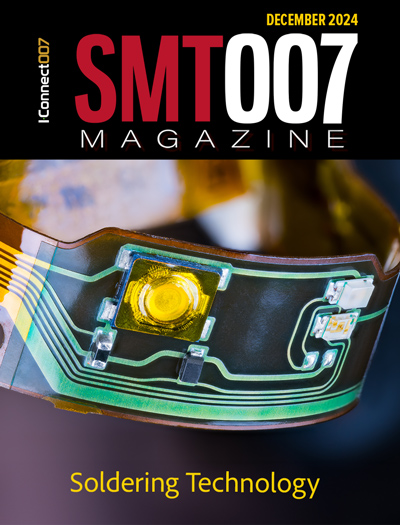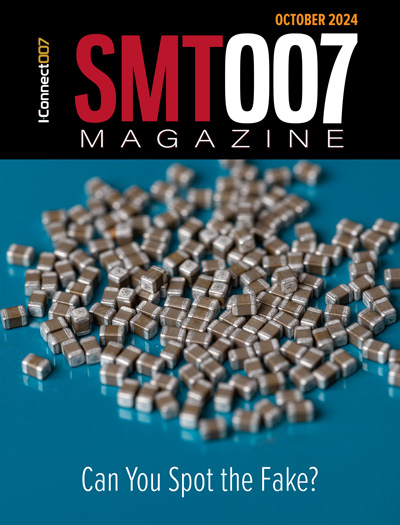-

- News
- Books
Featured Books
- smt007 Magazine
Latest Issues
Current Issue
Soldering Technologies
Soldering is the heartbeat of assembly, and new developments are taking place to match the rest of the innovation in electronics. There are tried-and-true technologies for soldering. But new challenges in packaging, materials, and sustainability may be putting this key step in flux.

The Rise of Data
Analytics is a given in this industry, but the threshold is changing. If you think you're too small to invest in analytics, you may need to reconsider. So how do you do analytics better? What are the new tools, and how do you get started?

Counterfeit Concerns
The distribution of counterfeit parts has become much more sophisticated in the past decade, and there's no reason to believe that trend is going to be stopping any time soon. What might crop up in the near future?
- Articles
- Columns
Search Console
- Links
- Media kit
||| MENU - smt007 Magazine
Cadence Partners with Antiviral Discovery Consortium to Spearhead Rapid Development of Treatments for Viral Pandemics
December 8, 2023 | Cadence Design Systems, Inc.Estimated reading time: 2 minutes
Cadence Molecular Sciences (OpenEye)—a business unit of Cadence Design Systems—will provide OpenEye’s molecular design software to power the open-science AI-driven Structure-enabled Antiviral Platform (ASAP) Discovery Consortium in support of an innovative effort to rapidly develop antivirals to prevent future pandemics.
John D. Chodera, PhD, a lab head at the Memorial Sloan Kettering Cancer Center (MSKCC), directs the researchers and software scientists building the computational chemistry infrastructure to support ASAP.
“Dr. Chodera and the ASAP scientists working with him will have access to OpenEye tools to help support the ASAP Discovery Consortium and antiviral drug research,” said Anthony Nicholls, PhD, corporate vice president, OpenEye, Cadence Molecular Sciences. “OpenEye’s software will aid in advancing therapeutics for under-researched diseases and to prepare for pandemics.”
OpenEye’s Applications, Toolkits and Orion® platform—which include ROCS®, FastROCS™, BROOD, OMEGA, OEChemTK, Grapheme™, Nonequilibrium Switching (NES) Free Energy Calculations and other tools—enable computational chemists working with the ASAP Discovery Consortium to build a robust antiviral drug discovery pipeline using technology, structural biology, artificial intelligence (AI), machine learning and computational chemistry.
“Open-science drug discovery against future pandemics is an essential public service,” said Chodera. “We are thrilled to have access to OpenEye’s industry-leading software in this effort. The OpenEye Toolkits have long been the backbone of our computer-aided drug discovery infrastructure, and access to the Orion NES Free Energy workflows allows us to run free energy calculations in mere hours.”
The ASAP Discovery Consortium is an Antiviral Drug Discovery (AViDD) U19 Center for Pathogens of Pandemic Concern funded by the National Institute of Allergy and Infectious Diseases (NIAID), part of the National Institutes of Health (NIH), via a $68 million grant as part of the Antiviral Program for Pandemics (APP).
The NIH grant is for the initial three-year phase of the ASAP Discovery Consortium, which aims to deliver multiple drug candidates ready for evaluation in humans in the event of an ongoing or emerging pandemic threat. The project will maximize the use of an open science model that prioritizes global, equitable and affordable access to antiviral medicine, generating a wealth of antiviral data shared rapidly and openly.
ASAP builds on the successes of the COVID Moonshot(opens in a new tab), a global, open-science collaboration that began in March 2020 and rapidly identified potent antivirals targeting the main protease of the SARS-CoV-2 virus. In July 2021, Moonshot received $11M in funding from the Wellcome Trust to pursue an accelerated preclinical program via the World Health Organization Access to COVID Tools Accelerator (ACT-A) and is working with the Drugs for Neglected Diseases Initiative (DNDi) to pursue clinical trials with a straight-to-generics model.
The ASAP Discovery Consortium is led by PIs John Chodera (MSKCC), Alpha Lee (PostEra) and Peter Sjö (DNDi). ASAP partners include the Diamond Light Source (UK), the Weizmann Institute of Science (Israel), Medchemica (UK), Mount Sinai (USA), the Stanford University School of Medicine (USA) and the Fred Hutchinson Cancer Center (USA), as well as a vast global network of scientists and industry collaborators.
Suggested Items
Ansys’ Collaboration with Schrödinger will Accelerate Materials Development with Unprecedented Multiscale Simulation
05/09/2024 | ANSYSAnsys and Schrödinger are collaborating to deliver an ICME approach that bridges the gap between materials discovery and product development.
PNNL Kicks Off Multi-Year Energy Storage, Scientific Discovery Collaboration with Microsoft
01/15/2024 | PNNLThe urgent need to meet global clean energy goals has world leaders searching for faster solutions. To meet that call, the Department of Energy’s Pacific Northwest National Laboratory has teamed with Microsoft to use high-performance computing in the cloud and advanced artificial intelligence to accelerate scientific discovery on a scale not previously demonstrated.
Beyond Liquid Crystal: DARPA Seeks Novel Tunable Optical Materials
06/13/2023 | DARPALiquid crystals are ubiquitous tunable optical materials most commonly known for the vibrant colors and sharp images they enable on flatscreen TVs, smartphones, tablets, and monitors.
Intel, Mila Join Forces for Responsible AI
09/15/2022 | IntelIntel has announced a three-year strategic research and co-innovation collaboration with Mila, an artificial intelligence research institute based in Montreal.
Cadence Completes Acquisition of OpenEye Scientific
09/02/2022 | Business WireCadence Design Systems, Inc. announced that it has completed the acquisition of OpenEye Scientific Software, Inc. (OpenEye).


